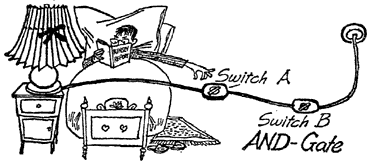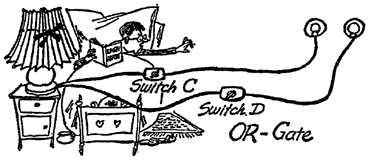Multiplication is Vexation
We must face the fact that electronic brains can combine their fundamental capabilities, and increase them by multiple repetition, with such speed that no human mathematical genius can keep up with them.
However, first of all, let us begin with addition. How does an electronic computer add?
It adds by actuating electric circuits. To make this clear, we shall have to advance a few steps into the realm of electricity. But you can take it easy - we shall be able to make ourselves understood even without a three-year course in electricity.
Gates and Flip-Flops
Every electronic computer - or more correctly, its counting mecbanism - is built up out of different kinds of basic circuits. There are "and-gates" (or "and-circuits"), "or-gates" (otherwise known as "or-circuits" or "buffers"), "negaters" and devices with the delightful name of "flip-flops." There are no more than just those four.
An and-gate ... well, is like a special bedside lamp, a small lamp with a long cord attached to it. The cord has not only one switch for the lamp, but two switches, as you see from Illus. 6. The lamp lights up only when both switches are turned on. That is an and-gate.

Illus. 6
It is’nt very intelligent, perhaps, to mount two switches in the cord of a bedside lamp. Such devices are common enough, however, in other kinds of electrical apparatus. For example, for safety's sake dangerous machines can only be made to start up when two switches are turned on at the same time.
But we wanted to talk about electronic computers, and in fact now about or-gates. Take that bedside lamp again! This time note that it has two leads, with one switch in each of them. To turn on the light, you can actuate one or the other. Or both of them.

Illus. 7
You will find negaters frequently in electric circuits, though unfortunately not in the familiar world of bedside lamps. So we shall have to ask you to use your imagination. A negater turns everything supplied to it into the opposite. If a negater is built into a line and current is sent through the wire, it switches the current off. If, however, you do not supply it with any current, it will fetch some, just to defy you, from some other source, and send it on. Negaters are needed in electronic computers to reverse the meaning of pulses: they will turn "0" ("no current") into "1" ("current"). "1" in the negater becomes "0."
Now for the "flip-flop." You may find something like it near the staircases of some modem houses and buildings. Ordinarily, you press a button and a bulb lights up; you press again and the light goes out. But imagine a button which allows the light to burn either on the first floor or on the second floor. At the moment, let's say, the light is burning on the first floor. You press the button: the light goes out below, and comes on on the second floor. Press the button again: the light goes out again on the second floor, but on the first floor it comes on again. The first press on the button is a "flip," so to speak, the second a "flop."
©
by PhiloPhax & Lauftext
& Redaktion Lohberg
Kybernetik
- Was ist das?
First printed in Germany: 1963